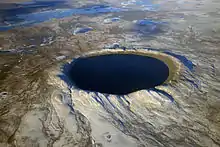Gatun structure
The Gatun structure is a possible eroded impact crater. It is named after the nearby Gatun Lake in Panama. It was first discovered in 1972 by geologist Bob Stewart and later studied by Livio L. Tornabene from the University of South Florida Department of Geology.
The structure is estimated to have formed about 20 million years ago, during the Miocene epoch. Despite the considerable erosion, it was possible to estimate the original diameter to have been 2.7 to 3 km, assuming the impact hypothesis is correct.
Although diagnostic evidence of impact has not been reported, evidence favoring an impact origin include the recovery of possible impact glass at the site. Alternatively, the site may be of volcanic origin.
References
- Tornabene, L. L., Stewart, R. H. Ryan, J. G. (2002). "The Gatun Structure: a petrographic and geochemical investigation into a possible Tertiary impact structure near Gamboa, Republic de Panama". LPSC XXXIII.CS1 maint: multiple names: authors list (link) PDF
- Tornabene, L. L., Stewart, R. H., Ryan, J. G. (2001). "A petrographic and geochemical investigation into the Gatun Structure, a possible Tertiary impact structure near Gamboa, Republic de Panama". AGU Spring Meeting. 82 (20): S249.CS1 maint: multiple names: authors list (link) Abstract
- Tornabene, L.L., Stewart, R. H., Ryan, J. G. (1999). "Characterization and Age of a Probable Tertiary Impact Site near Gamboa, Panama Canal Zone". GSA Annual meeting. 31 (7): 174.CS1 maint: multiple names: authors list (link)
This article is issued from Wikipedia. The text is licensed under Creative Commons - Attribution - Sharealike. Additional terms may apply for the media files.

